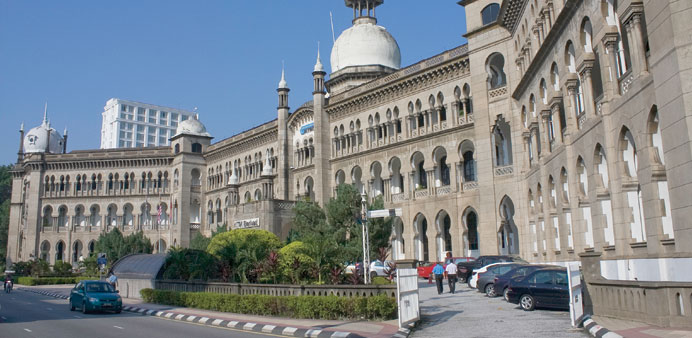The KTM administration building was the last of the Mogul-style buildings to be built in Kuala Lumpur in the last century. It was erected in 1917.
By John Grafilo
In the past four months, conservationists in northern Malaysia’s fast-developing town of Kuala Terengganu have been campaigning against a plan by the state government to redevelop a landmark marketplace into a shopping complex and five-star hotel.
The 46-year-old Pasar Payang wet and dry market, a maze of about 200 stalls selling native crafts and products found in the region, has been declared unsafe by the Terengganu state’s public works department and a redevelopment plan was announced in February.
Kamarul Bahrin Ahmad, an architect and leader of the Save Pasar Payang Campaign, said the plan would rob Kuala Terengganu of a heritage building and would displace the traders in the market.
But Ahmad Said, chief minister of Terengganu, said the market’s redevelopment would be for the convenience of the traders, consumers and tourists.
On January 28, a passenger train pulled out for the last time at the 96-year-old Alor Setar railway station in the nearby state of Kedah.
Glum-faced commuters took their last glance at the semi-wooden station that will soon be demolished to give way to a modern electrified, double-track railway project.
For the past three decades, century-old shop houses and small town landmarks in Malaysia have been crushed by the necessities of progress such as intertwining highways, skyscrapers and shopping malls, as the country bids to become a fully developed nation by 2020.
While the government has been successful in preserving iconic structures with national historical values, it has proved wanting in conserving landmarks in small communities, said Elizabeth Cardosa, a leader of local conservation group Badan Warisan. Architect Laurence Loh, who led the restoration of a heritage building called Blue Mansion in the northern state of Penang, urged the government to do more in preserving the country’s rich built heritage, a blend of oriental and occidental design and construction.
“The challenge is how to balance urbanisation and the encroachment of development and the life as before,” he said. “Conservation is the act of buying time, giving space for people to sort out and manage change in a controlled pace.”
Zuraina Majid, commissioner of Malaysia’s Department of National Heritage, said the government cares about the country’s heritage as manifested by the passage of a comprehensive law that led to the creation of her office in 2006.
But Zuraina said not all old structures can qualify as heritage sites since the law set criteria on what should be considered national heritage and what should be conserved.
“There are many things that are old, we have to prioritise which one we want to rescue, we cannot have more of the same because we don’t have that luxury of saving everything,” she said. “Old does not mean it has to be preserved,” she added. “It has to have technological value, architectural value, historical value.”
Zuraina said the successful preservation of the historical colonial towns of George Town and Malacca, which were declared Unesco World Heritage sites in 2008, is an example of the government’s determination to preserve the country’s built heritage.
She said at present her office has classified 240 heritage buildings throughout the country and 47 more buildings have been inscribed as national heritage.
Badan Warisan, a pioneering non-profit heritage conservation organisation that lobbied for the passage of the country’s national heritage law since the late 1980s, said Malaysia’s old charm goes beyond national iconic heritage structures.
Cardosa, its executive director, said that rows of century-old shop houses might not qualify as national heritage, but these structures could have historical significance to the development of the town and to the townsfolk residing in the area.
She cited the partnership between residents and conservationists in preserving and restoring an abandoned rubber plantation smokehouse in the one-street town of Lunas in the northern state of Kedah which was founded in the early 1900s.
“First we map the town,” she said. “We look at the timeline and how the town grew and we marked the iconic buildings within the town which was really a Hindu temple, a rubber plantation, a couple of big houses.”
“We restored an old smokehouse and turned it into a gallery celebrating the town’s history and the people who lived there,” she added. “The townsfolk suddenly remembered their history and they became very proud of their town.”
Cardosa said their initiative became a moving force that impelled residents to take pride and preserve their shop houses. Lunas has become well known for its restored century-old shop houses and residences.
While Badan Warisan helps in the various initiatives of the National Heritage Department, Cardosa said her group is also closely working with the planning department under the housing and local government ministry.
“They (planners) are the ones who can say yes, you can build, no, you cannot build, yes, you can destroy, no, you can’t destroy,” she said.
Last year, Badan Warisan launched workshops aimed at training city and town planners on how to appreciate and assess the historical and cultural importance of buildings in their areas of jurisdiction.
Cardosa expressed hope that when the planners become aware of the historical and cultural value of a place, such as a town market or a row of shop houses, they would take these into consideration when planning roads, economic activities and other infrastructure.
Laurent Lim, head of Malaysia Institute of Architects’ heritage and conservation committee, noted an increasing awareness among Malaysians of the need to conserve heritage buildings.
“Even the private developers realised that it is actually profitable to restore old buildings,” he said. “They realise that tourists would like to see old buildings, old environments that are well preserved and conserved.”
Laurent said he hopes that the government will provide people who want to restore heritage buildings with incentives in order to boost conservation efforts. — DPA



